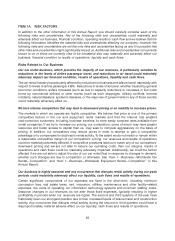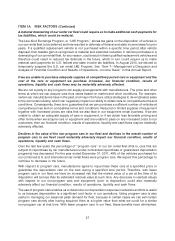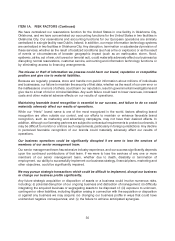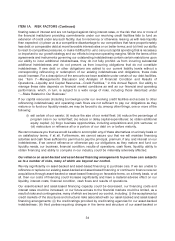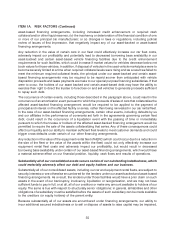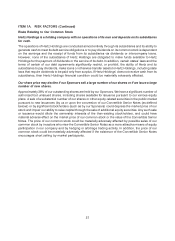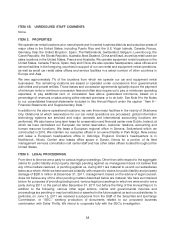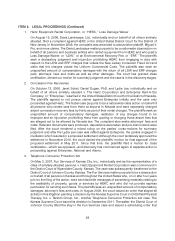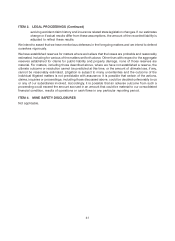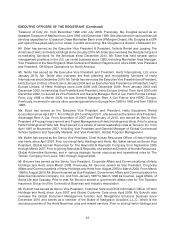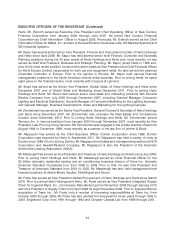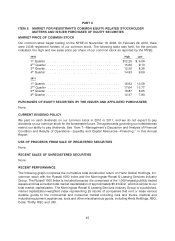Hertz 2011 Annual Report Download - page 61
Download and view the complete annual report
Please find page 61 of the 2011 Hertz annual report below. You can navigate through the pages in the report by either clicking on the pages listed below, or by using the keyword search tool below to find specific information within the annual report.ITEM 1A. RISK FACTORS (Continued)
asset-based financing arrangements, including increased credit enhancement or required cash
collateral and/or other liquid reserves; (iv) the insolvency or deterioration of the financial condition of one
or more of our principal car manufacturers; or (v) changes in laws or regulations, including judicial
review of issues of first impression, that negatively impact any of our asset-backed or asset-based
financing arrangements.
Any reduction in the value of certain cars in our fleet could effectively increase our car fleet costs,
adversely impact our profitability and potentially lead to decreased borrowing base availability in our
asset-backed and certain asset-based vehicle financing facilities due to the credit enhancement
requirements for such facilities, which could increase if market values for vehicles decrease below net
book values for those vehicles. In addition, if disposal of vehicles in the used vehicle marketplace were to
become severely limited at a time when required collateral levels were rising and as a result we failed to
meet the minimum required collateral levels, the principal under our asset-backed and certain asset-
based financing arrangements may be required to be repaid sooner than anticipated with vehicle
disposition proceeds and lease payments we make to our special purpose financing subsidiaries. If that
were to occur, the holders of our asset backed and certain asset-based debt may have the ability to
exercise their right to direct the trustee to foreclose on and sell vehicles to generate proceeds sufficient
to repay such debt.
The occurrence of certain events, including those described in the paragraph above, could result in the
occurrence of an amortization event pursuant to which the proceeds of sales of cars that collateralize the
affected asset-backed financing arrangement would be required to be applied to the payment of
principal and interest on the affected facility or series, rather than being reinvested in our car rental fleet.
In the case of our asset-backed financing arrangements, certain other events, including defaults by us
and our affiliates in the performance of covenants set forth in the agreements governing certain fleet
debt, could result in the occurrence of a liquidation event with the passing of time or immediately
pursuant to which the trustee or holders of the affected asset-backed financing arrangement would be
permitted to require the sale of the assets collateralizing that series. Any of these consequences could
affect our liquidity and our ability to maintain sufficient fleet levels to meet customer demands and could
trigger cross-defaults under certain of our other financing arrangements.
Any reduction in the value of the equipment rental fleet of HERC (which could occur due to a reduction in
the size of the fleet or the value of the assets within the fleet) could not only effectively increase our
equipment rental fleet costs and adversely impact our profitability, but would result in decreased
borrowing base availability under certain of our asset-based financing arrangements, which would have
a material adverse effect on our financial position, liquidity, cash flows and results of operations.
Substantially all of our consolidated assets secure certain of our outstanding indebtedness, which
could materially adversely affect our debt and equity holders and our business.
Substantially all of our consolidated assets, including our car and equipment rental fleets, are subject to
security interests or are otherwise encumbered for the lenders under our asset-backed and asset-based
financing arrangements. As a result, the lenders under those facilities would have a prior claim on such
assets in the event of our bankruptcy, insolvency, liquidation or reorganization, and we may not have
sufficient funds to pay in full, or at all, all of our creditors or make any amount available to holders of our
equity. The same is true with respect to structurally senior obligations: in general, all liabilities and other
obligations of a subsidiary must be satisfied before the assets of such subsidiary can be made available
to the creditors (or equity holders) of the parent entity.
Because substantially all of our assets are encumbered under financing arrangements, our ability to
incur additional secured indebtedness or to sell or dispose of assets to raise capital may be impaired,
35



